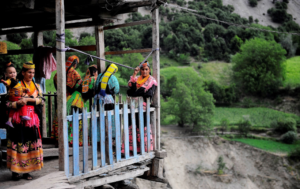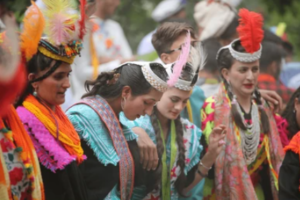Introduction: Who are the Kalash People?
In the isolated valleys of the Hindu Kush mountain range in Pakistan, the Kalash people stand as one of the world’s most fascinating and unique communities. This small but resilient group numbering around 3,500 to 5,000 individuals has managed to preserve its ancient culture traditions and language despite the pressures of modernization and external influences. Often described as the last pagans of the Hindu Kush the Kalash are known for their vibrant festivals distinct attire and deep-rooted beliefs.
This blog post will explore who the Kalash people are where they live their customs and the challenges they face. Using the PSA copywriting framework—Problem Solution and Action—we’ll address factual insights, dispel misconceptions and emphasize. Why preserving the Kalash culture matters to us all.
The Problem: Kalash People Under Cultural Threat

The Kalash people reside in three main valleys—Bumburet Rumbur and Birir—in the Chitral district of northern Pakistan. These regions are remote with rugged mountain landscapes that have historically provided both a natural barrier and protection for the community.
While their secluded location has kept the Kalash relatively insulated for centuries modern challenges now threaten their cultural heritage:
- Population Decline: The Kalash population is decreasing. Current estimates place their numbers at less than 5,000 compared to earlier centuries when they were more widespread.
- Cultural Assimilation: Increased contact with neighbouring communities and modern influences has led to gradual cultural assimilation. Many Kalash youth are adopting mainstream traditions potentially leaving behind their ancestral customs.
- Lack of Economic Resources: The Kalash people primarily depend on subsistence agriculture livestock and tourism. However their remote location limits opportunities for education healthcare and economic growth.
- Religious Pressures: The Kalash follow an ancient animistic religion which sets them apart in a region where other religious beliefs dominate. There have been efforts to convert members of the Kalash community threatening their spiritual identity. These challenges pose a significant risk to the continuity of Kalash culture. The question we must
- ask is: Can this centuries-old heritage survive the tides of time?
The Solution: Celebrating and Supporting the Kalash People

To protect and preserve the Kalash culture, it is crucial to highlight their way of life and bring global awareness to their challenges. Through education tourism and community-driven initiatives, the Kalash people can continue to thrive.
1. Understanding Kalash Culture and Beliefs
The Kalash people follow a previous multi-faith religion based on animism. Their belief system celebrates nature, ancestors, and deities like Balumain and Jestak. Unlike many neighbouring communities the Kalash do not build mosques or temples. Instead, they worship outdoors often in sacred groves or at community gathering sites.
Their festivals are a cornerstone of their identity providing insight into their spiritual and social lives:

- Chilam Joshi (Spring Festival): Celebrated in May this event honours fertility and the coming of spring. Kalash men and women don vibrant handmade dresses and participate in singing, dancing, and feasting.
- Uchal (Harvest Festival): In August, the Kalash celebrate the harvest season with communal gratitude. Traditional songs and dances accompany rituals thanking their gods for the bountiful crops.
- Chaumos (Winter Solstice Festival): This December festival marks the year’s end with religious rituals, purification ceremonies, and joyful gatherings. The Chaumos celebration involves sacrifices and prayers to ensure prosperity in the coming year.
The Kalash festivals not only bring together families and neighbours but also attract global visitors eager to witness this extraordinary cultural expression.
2. Kalash Language and Identity

The Kalash language known as Kalasha-mun is part of the Indo-Iranian linguistic family. It is unique and spoken primarily in their valleys. However, it is classified as critically endangered by UNESCO due to its limited speakers and lack of formal preservation efforts.
- To protect this language, community initiatives are essential.
- Local schools can integrate Kalasha-mun into their curriculum.
- Efforts should be made to create written and digital records of the language
- And anthropologists can collaborate with the Kalash to document stories songs and traditions.
3. Tourism: A Sustainable Opportunity
Tourism has emerged as one of the key economic drivers for the Kalash people. Travelers from around the world are drawn to the Kalash valleys to experience their unique culture and scenic beauty. However, tourism must be handled responsibly to ensure that the Kalash way of life is not commercialized or harmed.
- Promoting Ethical Tourism: Visitors should respect local traditions and customs. Guided tours by Kalash community members can help bridge cultural understanding while providing economic benefits.
- Cultural Centers and Museums: Establishing cultural centres can educate tourists about Kalash history, traditions, and daily life without disrupting their communities.
4. Empowering the Kalash Woman

Kalash women are highly respected within their community. They wear beautifully embroidered black dresses adorned with vibrant colours and beadwork a tradition passed down for generations.
Women also play an active role in household chores agriculture and festivals. However, limited access to education and healthcare remains a barrier for many Kalash women. Addressing these needs through local programs women’s cooperatives and healthcare initiatives can empower them to sustain their cultural contributions.
The Action: What Can You Do to Help?
Preserving the Kalash culture requires collective action. Whether you are a traveller historian student or global citizen you can contribute to protecting this endangered heritage.
- Educate Yourself and Others
Knowledge is the first step to preservation. Share information about the Kalash people with friends, and family, and on social media platforms. The more people know the stronger the support for preserving this community becomes.
Read books watch documentaries and explore case studies on the Kalash people.
Use platforms like blogs videos and podcasts to spread awareness.

- Visit the Kalash Valleys Responsibly
- If you plan to travel to the Kalash valleys do so ethically and respectfully.
- Hire local guides who belong to the Kalash community.
- Support local businesses in buying authentic handmade products and avoid exploiting their traditions for photos or souvenirs.
- Follow guidelines for respectful tourism such as dressing modestly and seeking permission before taking photographs.
-
Support NGOs and Local Initiatives
Several organizations are actively working to preserve the Kalash culture by building schools that offer healthcare and promote sustainable tourism. Donating to such initiatives can have a direct impact on the community.
Organizations like the Kalash People Development Network (KPDN) are creating opportunities for education and livelihood.
NGOs focused on language preservation and women’s empowerment can play a significant role in keeping Kalash traditions alive.

- Document and Share Kalash Stories
- Help preserve the intangible heritage of the Kalash people.
- Document their songs dances and rituals in videos and articles.
- Encourage linguists to collaborate with the Kalash to protect their endangered language.
- Support academic research that highlights their unique customs and beliefs.
Case Study: A Story of Resilience and Cultural Revival

The Kalash people are resilient in the face of adversity. A recent case study highlights the efforts of the Kalash People Development Network (KPDN), which partnered with local schools to introduce Kalasha-mun classes for children. This initiative not only preserves the Kalash language but also instils a sense of pride among the younger generation.
Additionally, community-led tourism projects have provided an alternative source of income for Kalash families. Visitors now have the chance to stay in guesthouses managed by locals ensuring a direct economic benefit for the community. These efforts demonstrate that cultural preservation and economic growth can go hand in hand when implemented thoughtfully.
Conclusion: Why Protecting the Kalash People Matters

The Kalash people are not just a cultural treasure of Pakistan—they are a living reminder of human diversity resilience and heritage. As their numbers decline and cultural pressures grow. We must act collectively to preserve their traditions language and identity for future generations.
By spreading awareness promoting ethical tourism and supporting local initiatives we can ensure that the Kalash continue to thrive in their ancestral valleys.
Let’s celebrate this unique community by valuing their traditions and stories—because once lost, cultural heritage can never be fully restored.
Final Call to Action
If you found this blog post insightful, share it with others to spread awareness about the Kalash people. Consider visiting the Kalash valleys or supporting NGOs working for their preservation. Together, we can make a difference.
Preserve. Celebrate. Support the Kalash People.
